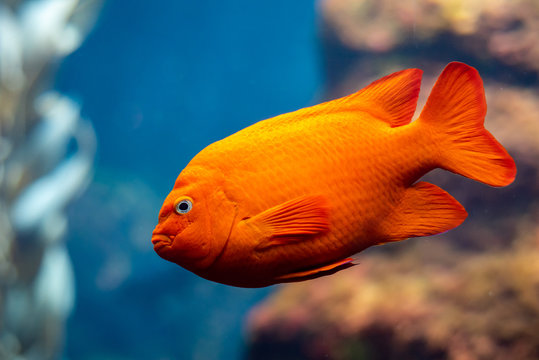ANIMAL: Garibaldi Hypsypops rubicundus Type of Animal: Damselfish Habitat: Kelp forest, shallow subtidal regions, reefs, kelp beds on exposed coastal shores, kelp beds on semi-exposed shallow bays near shorelines, clear water near crevices/small caves/kelp, rocky shorelines below low-tide mark, rocky ocean bottoms, found as deep as 100 ft Location(s): E Pacific, ranging from Monterey Bay, CA to Baja California Sur Appearance: Unmistakable deep bright orange fish w/ opaque tail/dorsal fin, juveniles reddish-orangish w/ small iridescent blue spots, similar coloration but male larger w/ noticeable frontal lobe Food/Diet: Sponges, algae, worms, nudibranchs, bryozoans, anemones, zooplankton, phytoplankton, eggs of own species, shrimp, crabs, sea stars, vegetable-based foods Status in Wild: Stable Conservation: Protected from fishing. Breeding in aquariums, aquaculture, & zoos. Lifestyle: Solitary, though small aggregations sometimes occur above reef territories. Territories often set up in very close proximity to one another. Additional Info: Called: Male Female Young: Fry Group: Aggregation Weight: Male: 1-2 lbs Female: 0.5-1 lb Gestation: 3 weeks Life Span: 12-25 years Body Length: Male: 12-15 in Female: 10-11 in Young: 8 in Tail Length: 1.3 in, same for both sexes Main predators are larger fish, sharks, pinnipeds, bald eagles, & pelicans. World’s largest damselfish. Also called Garibaldi Damselfish, Catalina Goldfish, & Marine Goldfish. While highly territorial, they’ll aggregate in areas above territories where fish investigate each other, possibly as way to choose mates. Both sexes highly territorial but males more so. Territories quite small w/ as many as 40 territories being able to fit in area size of basketball court. During March, male starts creating nesting area in territory, removing debris & biting away all plant growth, except for a few red algae species. He becomes even more territorial than usual during spawning/nesting season. From April-July, he’ll attract females to nest by spinning in circles & making loud clucking sounds. Females much more attracted to sites w/ freshly laid eggs. Males even eat blackened/older eggs to attract more females. Once females lay eggs, he forces them out (females often eat eggs). Once eggs incubated, male becomes even more aggressive, guarding eggs fiercely, even attacking/biting divers who come too close. Single female will lay 15,000-80,000 eggs per spawning cycle. When eggs hatch, they scatter into plankton. Females very choosy & visit as many as 15 nests before making up their minds. Active during the day (diurnal). Sexually mature at 4-5 years old. Fun Fact(s): When disturbed, they can emit audible thumping sounds. California’s state marine fish. Named Garibaldi after Italian political figure Giuseppe Garibaldi, who went often wore orangish-reddish clothes.
